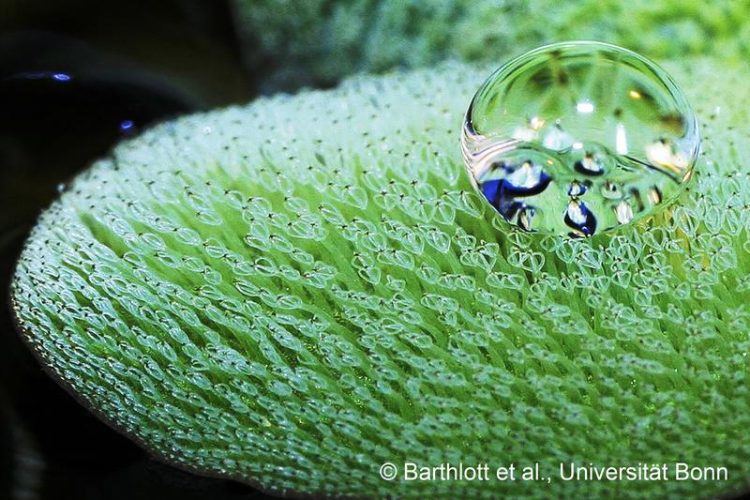Lubricant for oil tankers

The aquatic fern Salvinia molesta traps underwater in a thin layer of air, which it can hold for many weeks. © Prof. Dr. Wilhelm Barthlott/Uni Bonn
Ships are among the worst fuel guzzlers in the world. Together, they burn an estimated 250 million tonnes per year and emit around one billion tonnes of carbon dioxide into the air – about the same amount as the whole of Germany emits over the same period.
The main reason for this is the high degree of drag between hull and water, which constantly slows the ship down. Depending on the type of ship, drag accounts for up to 90 percent of energy consumption. This also makes it a huge economic factor: After all, fuel consumption is responsible for half of transport costs.
Drag can be significantly reduced using technical tricks. For example, the so-called “microbubbles technology” actively pumps air bubbles under the hull. The ship then travels over a bubble carpet, which reduces drag. However, the production of the bubbles consumes so much energy that the total savings effect is very small.
Coatings retain air for weeks
Novel high-tech coatings may promise a solution. They are able to hold air for long periods of even weeks. “Around ten years ago, we were already able to demonstrate on a prototype that in principle it is possible to reduce drag by up to ten percent,” explains Dr. Matthias Mail from the Nees Institute for Biodiversity of Plants at the University of Bonn, one of the authors of the study. “Our partners at Rostock University later achieved a 30-percent reduction with another material developed by us.”
Since then, various working groups have taken up the principle and developed it further. The technology is not yet mature enough for practical use. Nevertheless, the authors forecast a fuel-saving potential of at least five percent in the medium term, but more likely even 20 percent.
In their publication in the renowned “Philosophical Transactions” of the British Royal Society, founded by Isaac Newton, they calculated the economic and ecological advantages this would bring. For example, a commercial container ship on its way from Baltimore (USA) to Bremerhaven could reduce its fuel costs by up to 160,000 US dollars. Worldwide, emissions of the greenhouse gas carbon dioxide would be reduced by a maximum of 130 million tonnes.
Taking into account the reduced growth of barnacles and other aquatic organisms, which causes enormous additional drag loss, this quantity even rises to almost 300 million tonnes. This corresponds to almost one percent of global CO2 emissions. “Of course, these figures are optimistic,” says Mail. “But they show how much potential this technology has.”
Hydrophobic floating fern
The high-tech layers are based on models from nature, such as the floating fern Salvinia molesta. This is extremely hydrophobic: When submerged and pulled out again, the liquid rolls off it immediately. After that, the plant is completely dry.
Or to be more accurate: It was never really wet in the first place. Because underwater the fern wraps itself in an extremely thin dress of air. This prevents the plant from coming into contact with liquid – even during a many weeks-long dive. Scientists call this behavior “superhydrophobic”.
Salvinia has tiny egg-beater-like hairs on the surface of its leaves. These are water-repellent at their base, but hydrophilic at their tip. With these hair-tips, the aquatic fern firmly “pins” a water layer around itself. Its little dress of trapped air kept in place by the water layer. Perhaps this principle will soon cause a sensation in a completely different context: as a potent lubricant for oil tankers.
Prof. Dr. Wilhelm Barthlott
Nees-Institut für Biodiversität der Pflanzen
University of Bonn
Tel.: +49 (0)228-73 2271
E-mail: barthlott@uni-bonn.de
J. Busch, W. Barthlott, M. Brede, W. Terlau, M. Mail: Bionics and green technology in maritime shipping: an assessment of the effect of Salvinia air-layer hull coatings for drag and fuel reduction. Phil. Trans. R. Soc. A 377: 20180263. http://dx.doi.org/10.1098/rsta.2018.0263
Media Contact
More Information:
http://www.uni-bonn.de/All latest news from the category: Studies and Analyses
innovations-report maintains a wealth of in-depth studies and analyses from a variety of subject areas including business and finance, medicine and pharmacology, ecology and the environment, energy, communications and media, transportation, work, family and leisure.
Newest articles

Witness Groundbreaking Research on Achilles Tendon Recovery
Achilles tendon injuries are common but challenging to monitor during recovery due to the limitations of current imaging techniques. Researchers, led by Associate Professor Zeng Nan from the International Graduate…

Why Prevention Is Better Than Cure—A Novel Approach to Infectious Disease Outbreaks
Researchers have come up with a new way to identify more infectious variants of viruses or bacteria that start spreading in humans – including those causing flu, COVID, whooping cough…

Durable, Efficient, Sustainable: The Rise of Cerium Oxide Thermal Switches
Groundbreaking cerium oxide-based thermal switches achieve remarkable performance, transforming heat flow control with sustainable and efficient technology. Cerium Oxide-Based Thermal Switches Revolutionize Heat Flow Control Thermal switches, which electrically control…



